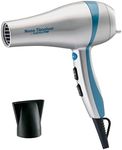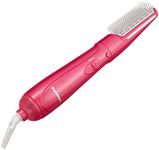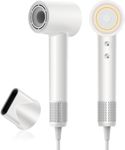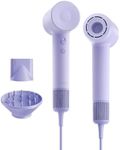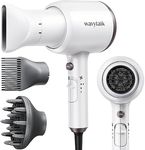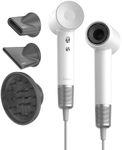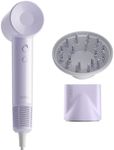Buying Guide for the Best Quiet Blow Dryers
Choosing a quiet blow dryer is all about finding a balance between noise level, drying performance, and features that suit your hair type and styling habits. Quiet blow dryers are designed to minimize the loud, high-pitched sound that many traditional dryers make, making them ideal for early mornings, shared living spaces, or anyone sensitive to noise. When shopping, it's important to look beyond just the decibel rating and consider how the dryer’s design, motor type, and additional features contribute to both quiet operation and effective drying. Understanding the key specifications will help you select a blow dryer that fits your needs and keeps your environment peaceful.Noise Level (Decibels)Noise level, measured in decibels (dB), tells you how loud the blow dryer will be during use. This is especially important if you want a quieter experience or live with others who might be disturbed by loud sounds. Blow dryers typically range from about 60 dB (very quiet) to over 85 dB (quite loud). For a quiet blow dryer, look for models in the 60-70 dB range. If you’re sensitive to noise or plan to use the dryer in the early morning or late at night, aim for the lowest decibel rating you can find. If noise is less of a concern, you can consider slightly higher values, but always compare this spec when quietness is a priority.
Motor TypeThe motor type affects both the noise level and the performance of the blow dryer. There are mainly two types: AC (alternating current) and DC (direct current) motors. AC motors are generally more powerful and durable but can be noisier, while DC motors are lighter and often quieter, though sometimes less powerful. Some high-end quiet dryers use brushless or digital motors, which are designed to be both efficient and quiet. If you want the quietest experience, look for dryers that specifically mention quiet or low-noise motors, and consider DC or brushless options if you have fine or short hair. For thick or long hair, you might need a balance between quietness and power.
WattageWattage indicates the power of the blow dryer and affects how quickly it can dry your hair. Higher wattage (1800-2000W) means faster drying, but sometimes at the cost of more noise. Lower wattage (1200-1600W) is usually quieter but may take longer to dry hair. If you have thick or long hair and want to minimize drying time, you might prefer a higher wattage, but if you have fine or short hair or prioritize quietness over speed, a lower wattage model could be a better fit.
Heat and Speed SettingsThe number and variety of heat and speed settings allow you to customize your drying experience. More settings give you greater control over noise and airflow. Lower speed and heat settings are generally quieter, so if you want a quiet blow dryer, look for models with multiple options. This way, you can use the lowest, quietest setting when needed, or switch to higher settings for faster drying when noise is less of a concern. Think about your hair type and how much control you want over the drying process when considering this spec.
Airflow TechnologySome blow dryers use special airflow designs or technologies, like ionic or ceramic, to enhance drying efficiency and reduce noise. These technologies can help dry hair faster at lower noise levels and may also reduce frizz or static. If you want a quiet and effective blow dryer, look for mentions of advanced airflow or noise-reducing technology. If your main goal is quietness, prioritize models that highlight these features, but also consider if you want the added benefits for your hair type.
Weight and ErgonomicsThe weight and design of the blow dryer affect how comfortable it is to use, especially for longer periods. Lighter, well-balanced dryers are easier to handle and less tiring, which is important if you have thick or long hair that takes longer to dry. While this doesn’t directly impact noise, a comfortable design can make the overall experience more pleasant, especially if you’re using the dryer at lower, quieter settings for longer times. Consider your own comfort and how often you’ll use the dryer when evaluating this spec.



